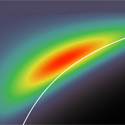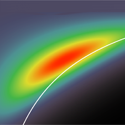Superconductor optics
Materials with a negative index of refraction bend and guide a beam of light in unconventional ways—an effect that could be exploited to make perfect lenses. The search for candidate negative-index materials has identified multilayers of high-temperature superconductors as a possibility. Because these materials are anisotropic, the sign of the electrical permittivity (or, more specifically, elements of the permittivity tensor) can change over a certain frequency range, which opens the possibility for negative-index refraction.
Writing in Physical Review Letters, Vladislav Golick and colleagues at Kharkov University in the Ukraine, in collaboration with scientists in the Ukraine, Russia, Japan, and the US, calculate dispersion curves for so-called “surface Josephson-plasma waves” in layered superconductors. They find a branch of these waves above the Josephson plasma frequency, displaying abnormal surface mode behavior. They also identify a window of THz frequencies (above the plasma frequency) where the permittivities switch signs to produce negative-index refraction. At higher frequencies, their model predicts that light incident through a high-index, transparent medium would be completely refracted (no reflection) inside the layered superconductor.
When the superconductor-layer width is below the free path of the surface waves, the refracted waves could be emitted from the edge of the superconductor in the form of a highly collimated beam. With a magnetic field applied parallel to the layers, it should be possible to modulate this channeling effect to make fast switching shutters and mirrors for guiding light. –Saad E. Hebboul





